5 Signs That Invasive Insects Are Slowly Killing Your Trees
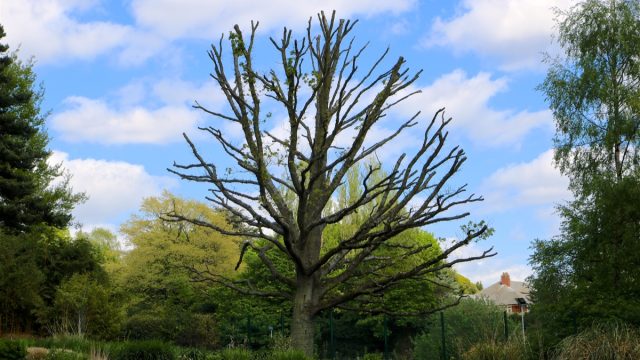
If you’re lucky enough to have trees in your yard, you know what a wonderful amenity they can be. They provide refuge from the summer sun, show off beautiful fall foliage, and offer sturdy branches for a bird’s nest or even a treehouse. With all of these benefits in mind (not to mention the positive impact they can have on your physical and mental health) we want to keep our trees thriving. However, invasive insects have the opposite goals in mind—and there are signs that they may actually be killing your trees slowly but surely.
“Since trees are so large, they often die from multiple problems at once, rather than one huge, catastrophic event (lightning strikes excepted!). For trees, it’s more like ‘death by a thousand cuts,’” Charles van Rees, PhD, conservation scientist, naturalist, and founder of the Gulo in Nature blog, tells Best Life. “Each additional pressure or threat can bring them one step closer to the edge. With climate change increasing the frequency of droughts, floods, heat waves, and extreme cold snaps, many tree species are already under a lot of stress. When invasive species come along and start chomping on them, that can be the straw that broke the camel’s back.”
Van Rees adds that damage from invasive species, in particular, is more severe than damage caused by native species. “It will also be more consistent year-to-year and is more likely to lead to tree death. In other words, the severity of damage (and of the infestation) will be greater for invasive species,” he says. This is compounded by the fact that invasive species don’t have natural predators to keep their population under control, wreaking even more havoc due to the rate at which they reproduce.
You might be able to spot the insects yourself, according to Julia Omelchenko, resident botanist expert for the NatureID app, but some signs are sneakier. To keep your trees alive and well, you’ll want to monitor them for any trace of invasive insects. Read on for five telltale signs that your trees are under siege.
READ THIS NEXT: 5 Invasive Trees You Need to Remove From Your Yard Immediately.
1
Wilted leaves
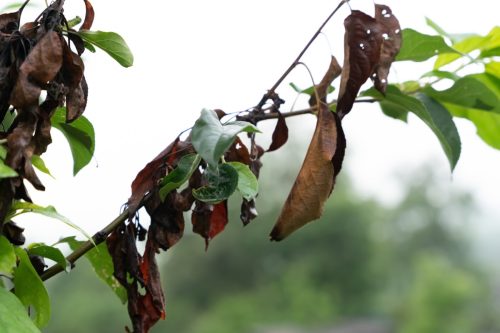
Seeing a tree with droopy foliage is always somewhat depressing, but did you know it could also be a sign of invasive insects?
“Leaves are typically kept perky and upright by turgor pressure, a force exerted by the water inside of its vascular tissue,” van Rees explains. “When the water stops moving or is no longer connected to the rest of the plant, the leaves will wilt. This is a bad sign for the plant; it often just means that it’s trying to conserve water during a drought.”
According to Jen Stark, master gardener and founder of Happy DIY Home, wilting leaves are one of the most common signs of invasive insects and could signal aphids or scale insects, specifically.
However, van Rees notes that if surrounding plants look like they’re faring well, the issue might be related to “systematic troubles” in your trees’ roots or trunk.
2
Sawdust or “frass” on the ground
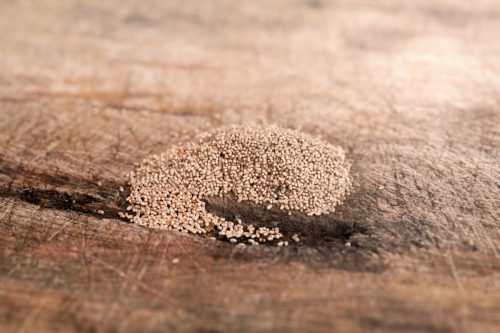
Just like humans and animals, insects have to eat—and as van Rees puts it, “what goes in must come out!”
“If you’ve got invasive critters in huge numbers, their droppings might start to become visible,” he says. “In leaf-eating species (especially caterpillars), little pill-shaped poo called frass will accumulate rapidly under the tree.” Sawdust, on the other hand, is just that—dust left behind by insects that chew through to the inside of trees.
Stark points to these signs as well, noting that frass or sawdust near a branch joint could indicate that your tree is infested with wood-boring beetles.
READ THIS NEXT: If You Have This Tree in Your Yard, Cut It Down Now, Officials Warn.
3
Oozing sap or honeydew
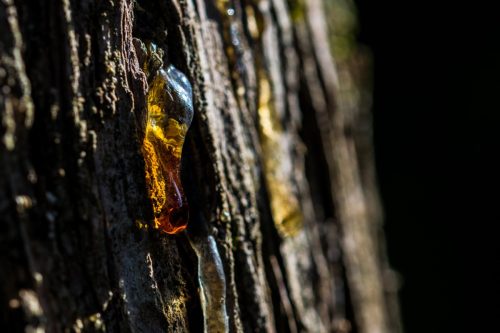
Trees that appear to be leaking sap may be in trouble, too, according to Stark—especially if you see it coming from cuts in the tree. The spotted lanternfly is one sap-sucking invasive that causes this symptom, leaving behind the “oozing wounds” after it’s done feeding.
Sap-suckers also excrete sugar and water, known as “honeydew,” according to van Rees. “This can stain the ground underneath it as fungi and other microbes feed on the sticky droplets accumulating below,” he says.
Van Rees calls insects that suck tree sap “plant vampires,” as they leave trees weak and feeble. “If their infestations get particularly bad (as with hemlock wooly adelgids), they can weaken and starve trees by consuming a large amount of their stored-up resources, or the food that they generate by photosynthesis,” he says. “This is bad news for the tree, and if it continues for a couple years, can make them likely to die.”
4
Missing leaves
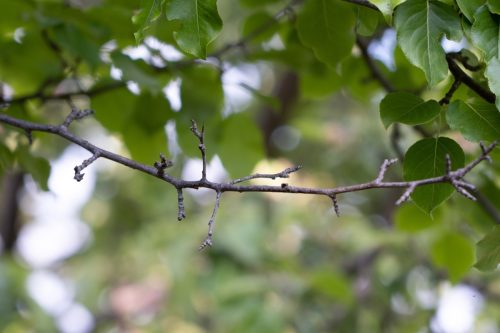
Unless it’s autumn, we don’t expect to find too many leaves on the ground. So if you notice missing leaves on your trees, formally known as defoliation, they might be infested with invasive species.
“If there is no sign of leaves at all, the plant may be dead, dying, or otherwise made unhealthy by damage from insects somewhere in its roots or vascular system,” van Rees says. “If there are partial leaves indicating folivory (leaf-eating), then something is probably chewing up the leaves as fast as they can grow!”
This makes it difficult for the tree to feed itself, as green leaves are used for photosynthesis, and after several years, your tree could become too weak to carry on, he adds.
One invasive defoliator is the spongy moth, according to the Connecticut Department of Energy & Environmental Protection. These pests eat almost all leaves on hardwood trees, affecting the reproduction process and making them more susceptible to diseases and other insects. The spongy moth (formerly known as the gypsy moth) got its new name thanks to the sponge-like clusters that typify its egg mass stage, which is another sign you can look for.
For more outdoor advice delivered straight to your inbox, sign up for our daily newsletter.
5
Holes in bark
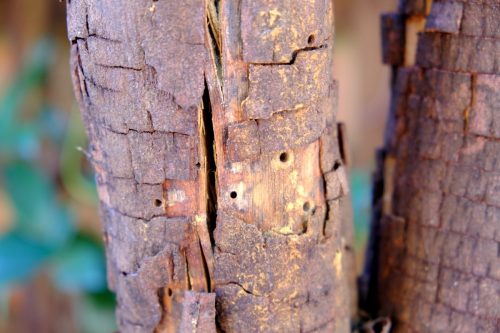
Holes in the bark of your tree probably aren’t a good sign either. These are left behind by wood-boring insects that chew through the tree trunk to feed, van Rees explains. “Of course, they don’t spend their entire lives in there, so they often leave noticeable holes, either on the way in or out,” he says.
The shape and arrangement of the holes are unique to different invasive insects, he adds, “but if you see lots of them on a tree, it may be a sign that something’s wrong.”
The emerald ash borer is one notorious wood-boring invasive, sometimes referred to as the EAB. The insect is native to Asia, and since its introduction to North America in 2002, it’s killed millions of native ash trees, according to the USDA Animal and Plant Health Inspection Service (APHIS). These pests are known for their emerald color, but if you have ash trees in your yard, keep an eye out for S-shaped galleries in the bark and D-shaped exit holes—the latter appearing throughout May and early June.
“In general, observation is key,” Omelchenko says. “If you notice leaf and bark damage, bite marks, and other signs of feeding, as well as pest activity, you need to take immediate action.”
Aside from knowing what kinds of trees you have in your yard (as invasive species have their “preferred host trees”), van Rees suggests using an outdoor app to identify the bug that’s killing your trees. From there, you can determine the appropriate treatment—whether that’s removing insects yourself, removing damaged parts, or using insecticide or fungicide, according to Omelchenko. Van Rees also recommends reporting sightings, which you can do through the EDDMapS app.